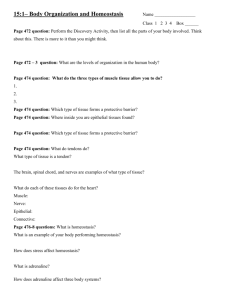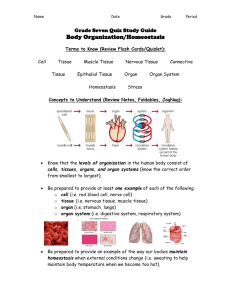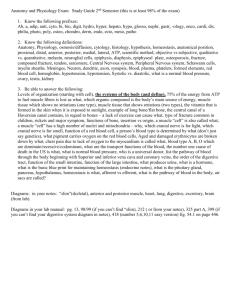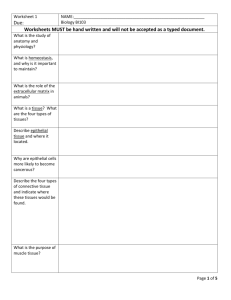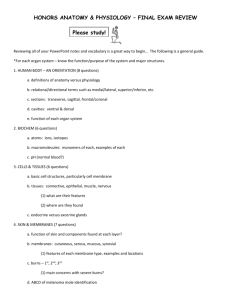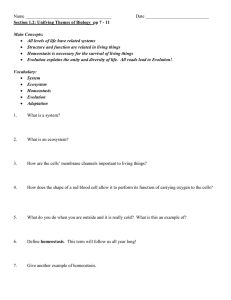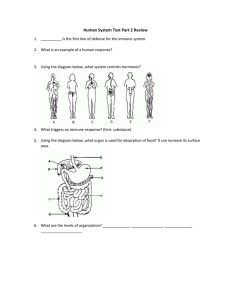INTRODUCTION TO PHYSIOLOGY
advertisement
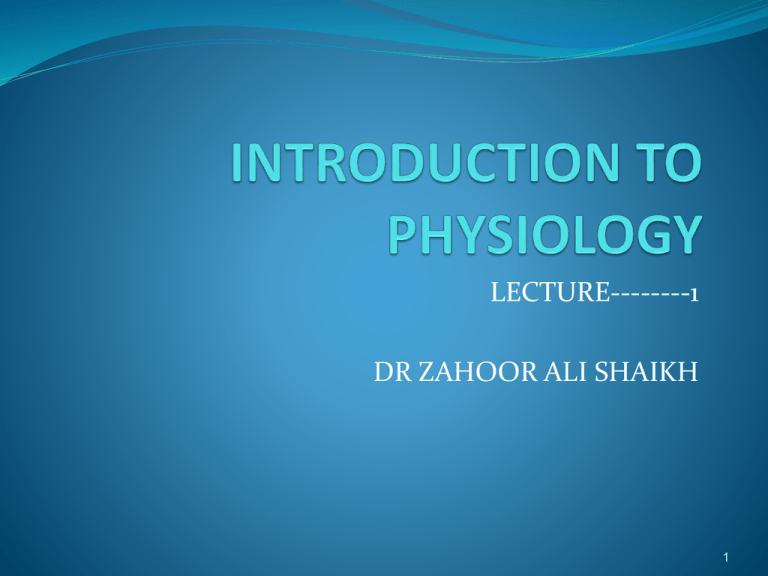
LECTURE--------1 DR ZAHOOR ALI SHAIKH 1 What is Physiology ? Physiology deals with functions of the body. Central aim is to keep the HOMEOSTASIS that is to keep the INTERNAL- ENVIORNMENT of the cell constant, so that cells can work. 2 Levels of organization in the Body Cells are basic units of life. Cell is the smallest unit which is capable of carrying out the processes associated with life. 3 Basic Cell Function Obtaining food and O2from the surrounding. Perform chemical reaction to use food and O2 Food + Oxygen = CO2+ H2O+Energy Eliminate CO2 and other waste products. Synthesize protein. Exchange of material through cell membrane. 4 Specialized Function of cells Digestive System - secrete digestive enzymes Muscle Cells - Muscle contraction Nerve Cell - send electrical impulses 5 Cells are organized in Tissues, Organs, Systems and finally Body. Cells of similar structure and function are organized in Tissues . 6 TYPES OF TISSUE There are FOUR types of Tissue 1- Muscle Tissue 2- Nervous Tissue 3- Epithelial Tissue 4- Connective Tissue 7 1. Muscle Tissue Muscle Tissue - for contraction THREE types of Muscles : 1– Skeletal Muscle 2– Cardiac Muscle 3– Smooth Muscle 8 2. NERVOUS TISSUE Nervous Tissue – Specialized cells for initiation and transmission of Electrical impulses Brain Spinal cord Nerves 9 3. Epithelial Tissue Two types 1. Epithelial lining e.g. Skin, Digestive system 2. Secretary glands e.g. Salivary glands 10 Glands – Two types Exocrine - Having duct e.g. salivary gland Endocrine - Ductless e.g. Thyroid gland 11 4. Connective Tissue Connective tissue connects, supports the body e.g. Tendon - attach skeletal muscle to bone Elastin - helps in stretching and recoil of the lungs 12 ORGANS Organs are composed of tissues (Two or more types ) to perform a particular function. E.g. stomach has all four primary tissues i.e. Epithelial, Muscle, Nervous and connective tissue. 13 BODY SYSTEMS Organs make the body system. Each system works to perform related functions and is essential for survival of body. E.g. – Digestive system works for digestion and absorption. 14 TOTAL BODY Composed of organ systems linked together structurally and functionally. 15 CONCEPT OF HOMEOSTASIS Body cells work in INTERNAL ENVIRONMENT that surrounds the body. What is Internal Environment ? It is aqueous(watery) Extracellular Fluid with which body cells are in direct contact it is outside the cell but not inside the cell. 16 Extracellular Fluid (ECF) What is Extracellular Fluid (ECF) ? ECF consists of -Plasma (fluid portion of blood) and Interstitial fluid (which surrounds the cells) Materials are exchanged between the plasma and interstitial fluid across the capillary membrane e.g. O2 and nutrition go from plasma to interstitial fluid than to cell Same way waste products go from cell to Interstitial fluid to plasma. 17 HOMEOSTASIS (continued) Homeo = Same Stasis = Stay Cells can only work when Internal environment (cell surrounding) physical and chemical state is within narrow physiological limits. Homeostasis is essential for survival of each cell. 18 HOMEOSTASIS (continued) All body system work for Homeostasis so that body can function. How body keeps Internal environment constant. E.g.- If CO2 increases – it affects respiration(increased) to get rid of increased CO2 -when cold outside, our body temperature decreases – shivering occurs to increase the body temperature. 19 HOMEOSTASIS (continued) For Homeostasis, Following factors are to be maintained constant: -supply of nutrient -concentration of O2 and CO2 -waste product concentration -pH as acidity affects enzyme activity -concentration of water and electrolytes - Temperature, narrow limit 35-38c - plasma volume and Blood pressure 20 Body Systems ELEVEN Body Systems work for Homeostasis : 1. Circulatory system 2. Digestive system 3. Respiratory system 4. Urinary system 5. Skeletal system 6. Muscular system 21 Body Systems (CONT) 7. Integumentary system- skin, hair, nails, sweat glands, temperature regulation 8. Immune system 9. Nervous system 10. Endocrine system 11. Reproductive system 22 What you should know from this Lecture What is Physiology ? What is Homeostasis? What is Internal Environment of the cell? What are the functions of cell? - General - Specialized • Organization of the body Cell – Tissue – Organs – System - Body 23 THANK YOU 24
